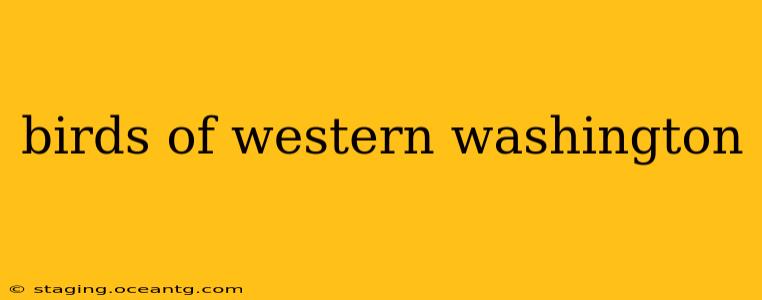Western Washington boasts a vibrant avian population, attracting birdwatchers from around the globe. From the rugged coastline to the lush rainforests, diverse habitats support a stunning array of species. This guide explores the rich birdlife of Western Washington, covering everything from common backyard birds to rare and elusive species. We'll delve into identification tips, prime birding locations, and answer frequently asked questions about birdwatching in this beautiful region.
What are some common birds found in Western Washington?
Western Washington's mild climate and abundant food sources support a wide variety of common bird species. You're likely to encounter many familiar faces, including:
- American Robin: A ubiquitous sight in yards and parks, easily identified by its reddish-orange breast.
- Northern Flicker: A striking woodpecker with a spotted back and a distinctive black crescent on its breast.
- Steller's Jay: A boisterous and intelligent bird with a vibrant blue crest and body.
- Downy Woodpecker: The smallest woodpecker in the region, easily distinguished by its black and white markings.
- Black-capped Chickadee: A tiny, energetic bird with a black cap and bib, a frequent visitor to backyard feeders.
- Song Sparrow: A brown bird with distinctive streaking and a cheerful song, found in a variety of habitats.
- House Finch: A common backyard bird with a reddish face in males and a streaked brown back.
- Mourning Dove: A gentle, grey bird with a distinctive mournful cooing sound.
What are the best places for birdwatching in Western Washington?
Western Washington offers a wealth of incredible birding locations catering to all skill levels. Here are a few highlights:
- Point Defiance Park (Tacoma): This expansive park features diverse habitats, including forests, wetlands, and shoreline, attracting a wide variety of species.
- Ebey's Landing (Whidbey Island): This stunning coastal area provides excellent opportunities for spotting shorebirds and seabirds.
- Sequim Bay (Olympic Peninsula): Known for its abundant waterfowl and shorebirds, particularly during migration seasons.
- Washington Park Arboretum (Seattle): A beautiful urban oasis with a variety of trails and habitats, offering chances to see various woodland birds.
- San Juan Islands: A true birding paradise, the islands support a rich array of seabirds, shorebirds, and raptors.
What are some rare or unusual birds I might see in Western Washington?
While common birds are abundant, Western Washington also occasionally hosts rare visitors. These sightings are often dependent on migration patterns and weather conditions. Keep an eye out for species like:
- Bald Eagle: While not entirely rare, seeing a Bald Eagle is always a special experience. Look for them near water bodies.
- Peregrine Falcon: This powerful falcon is sometimes sighted in urban areas and along the coast.
- Snowy Owl: An infrequent winter visitor from the Arctic, usually seen in open fields and along the coast. Sightings are usually unpredictable.
- Various warblers and flycatchers: Migration seasons bring a variety of these colorful birds through Western Washington.
What is the best time of year to go birdwatching in Western Washington?
Migration seasons (spring and fall) are peak times for birdwatching in Western Washington. Spring brings a surge of breeding birds returning from their wintering grounds, while autumn witnesses a spectacular wave of southbound migrants. However, every season offers unique opportunities: winter brings wintering waterfowl and raptors, while summer showcases nesting birds in their breeding territories.
What equipment do I need for birdwatching in Western Washington?
While not strictly necessary, having the right equipment can significantly enhance your birding experience:
- Binoculars: Essential for getting a closer look at birds. Choose binoculars with good magnification and clarity.
- Field Guide: A comprehensive field guide specific to Western Washington birds will help with identification.
- Camera (optional): A camera with a good zoom lens can allow you to capture stunning photos of your avian discoveries.
- Clothing: Dress in layers suitable for varying weather conditions. Waterproof clothing is particularly useful.
Where can I learn more about birds in Western Washington?
Several organizations dedicated to bird conservation and education operate in Western Washington. These groups often offer workshops, guided bird walks, and educational resources. Local nature centers and libraries can also provide valuable information and resources for bird identification and birding locations.
This guide provides a foundation for exploring the fascinating avian world of Western Washington. Remember to respect wildlife, maintain a safe distance, and leave the natural environment as you found it. Happy birding!
